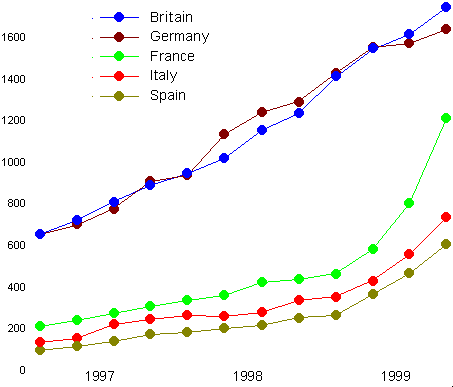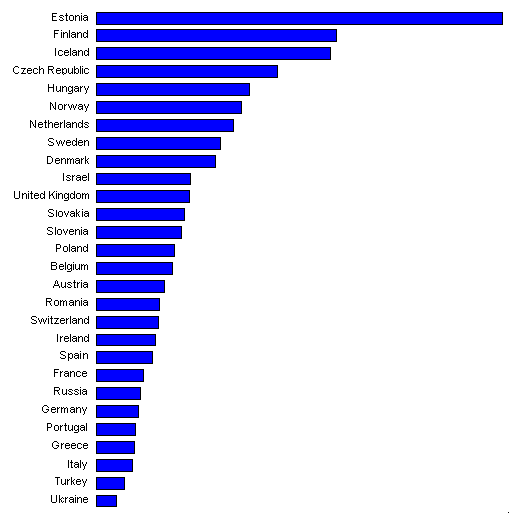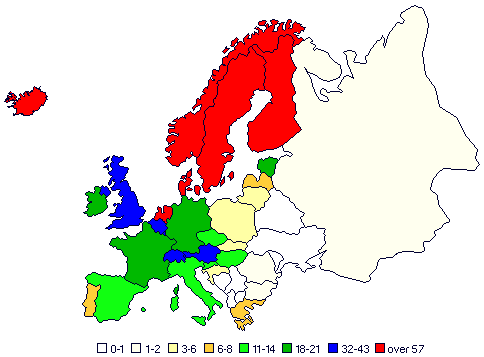No. 42 – December 18, 1999 |
 |
1. Editorial: The bogus millennium |
|
|
This is the last issue of Netmarketing in 1999; but not the last in the century or the millennium. The reason is quite simple: the 20th century will end at midnight in December 31, 2000; not in a few days' time. The worldwide "millennium craze" is a mistake in arithmetic. As such, it isn't important; but it's an example of how almost anything, no matter how absurd, can be perceived as "true" if it's repeated often enough.
Serious writers all over the world have been pointing out the mistake. An association of Spanish astronomers, AstroRed, has published a manifesto on this subject. But we continue to read about it in the same newspapers, and hear about it on the same television networks, where there have been reports about why it's a mistake. The nonsense is everywhere, on candy boxes and wine bottles, in all sorts of advertising (from beer to jewels, from banks to food), on businesslike diaries or on countless calendars with pictures of undressed mannequins.
Some people think it's a deliberate commercial swindle. Not a very successful one, in any case; people seem prepared to believe in the fake millennium as a theory, but not to pay real money for it. In my country there is a pending case against some travel agents for misleading advertising; I dont' know if it will be judged to be misleading, but it hasn't been effective: here as elsewhere, overpriced travel services and hotels aren't selling and are rushing to offer discounts. Of course when anything is as loudly proclaimed as this there are commercial interests trying to exploit it. But I don't think it started as a deliberate plot; it looks more like just a stupid mistake, picked up and repeated by careless broadcast media on an unbelievable global scale.
This isn't very important. It will soon be forgotten and won't come up again until 2099. But it's a symptom of a serious problem. Before I draw any conclusion, lets' look at another legend. In all sorts of books, presentations, etc. (including a report by the US Department of Commerce in 1998) there is a comparison of the speed of growth in three communication systems.
Growth from 0 to 50 million users
radio – 38 years
television – 13 years
internet – 4 years
It's quite easy to prove that it's nonsense. Most people say the internet was born 30 years ago. That's questionable; we could pick other dates for its birth, between 1965 and 1983. We don't know when it reached 50 million users, but it wasn't before 1995. Therefore the period could be anything between 12 and 30 years – but, in any case, not four. This isn't quite as irrelevant as it sounds. The fact that the internet did not grow faster than other communication systems proves that it's much more solid than any passing fad; it's here to stay, and will continue to grow. It's in its early stages of development and most of its worldwide growth is still ahead of us.
The real problem isn't which particular piece of nonsense we are "believing" at this time. It's the way information spreads. It's our "gullibility" in accepting the most ridiculous statements as "true" if they are repeated often enough. It's the unforgivable superficiality of broadcast media in hardly ever checking what they are picking up from a source and delivering to their readers or viewers. The problem is not so much the information overload as the fact that such a large part of that information is misleading. The strongest tool we have to overcome this problem is the internet. But even that won't work unless a large and growing number of people learns to use it effectively to look beyond the smokecreens and under the surface and find what is really useful for whatever any one of us is trying to learn or do.
back to top
|
 |
2. More numbers and more changes in Europe |
|
|
Let me start with the usual disclaimer. Of course all statistics have problems; also hostcount data are not immune from glitches. It doesn't make much sense to report data every month; we need to follow trends over a longer period before we can have a meaningful picture. However, there are changes in Europe at this time that are worth checking. So here is an update based on November data published by RIPE on December 13. The most relevant change is that we are, at last, seeing the results of the commitment by the French government and economic leaders to shift the traffic from the old minitel to the internet.
This is what we see now in a chart including the 13 European countries with over 200,000 internet hosts.
Internet hosts in 13 European countries
| |
1998 |
1999 |
Growth
in a year |
Hosts per
1000 inhab. |
| United Kingdom |
1,436,478 |
1,747,727 |
+ 22 % |
32.7 |
| Germany |
1,429,538 |
1,635,076 |
+ 14 % |
19.3 |
| France |
486,839 |
1,207,817 |
+ 147 % |
20.7 |
| Netherlands |
594,547 |
896,246 |
+ 51 % |
57.5 |
| Italy |
370,424 |
733,108 |
+ 96 % |
12.8 |
| Spain |
298,730 |
539,113 |
+ 81 % |
13.8 |
| Sweden |
417,894 |
539,113 |
+ 25 % |
59.0 |
| Finland |
465,335 |
492,513 |
+ 6 % |
96.0 |
| Norway |
319,628 |
375,212 |
+ 17 % |
85.5 |
| Denmark |
293,927 |
347,127 |
+ 17 % |
65.6 |
| Belgium |
203,660 |
331,951 |
+ 63 % |
32.8 |
| Switzerland |
231,094 |
300,249 |
+ 30 % |
42.5 |
| Russia |
193,837 |
240,752 |
+ 24 % |
1.6 |
| European Union |
6,330,690 |
8,923,088 |
+ 41 % |
22.6 |
| Total area |
7,815,458 |
10,215,307 |
+ 31 % |
14.5 |
Note: data are adjusted as indicated in issue 40
Only five of these countries (France, Italy, Spain, Belgium and the Netherlands) and only one more country in the European Union (Greece) grew faster than the European average in the last twelve months. There are still considerable differences in density, but they are not as large as they used to be. It will take years before the situation in Europe is "balanced", but there is a definite trend in that direction.
Now let's look a the same three graphs that we saw in the issue 41. The first shows growth in the five "large" countries in the European Union. "Weighting" criteria are somewhat changed and as a result trends are somewhat more believable; though of course we shall need results for the entire third quarter, and later for the first quarter of year 2000 (as well as worldwide data that will be available in February or March) to have a more relevant picture.
Internet hosts in 5 European countries – 1997-1999
Source: RIPE (Réseaux IP Européens) – quarterly data – numbers in thousands
|

|
Note: figures for he last quarter of 1999 are based on October-November data, as of course December statistics are not yet available. The figures for each quarter are the highest reported in the period (following the criteria explained in issue 40). Some figures are adjusted to reduce the effect of temporary fluctuations.
Of course the biggest change is in France. But, if the data in the next few months follow the same trend, we may be seeing the beginning of a reduction in the traditional gap between the two leading countries and the other large markets in Western Europe.
Now let's see the two usual graphs. The fist shows density.
Internet hosts per 1000 inhabitants
in 28 countries in the Europe-Mediterranean area
28 countries (of 100 in the RIPE area ) with over 20,000 hosts

|
|





